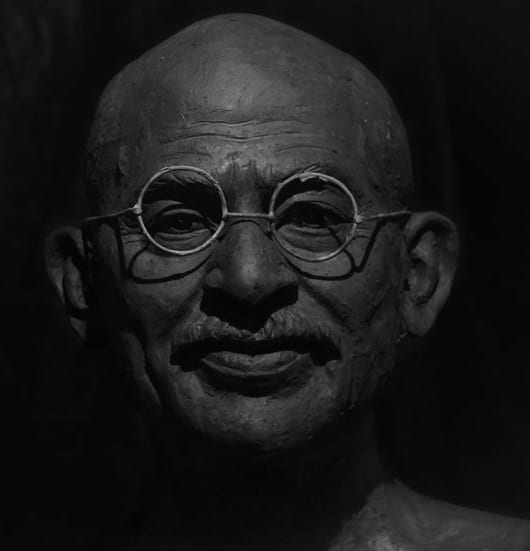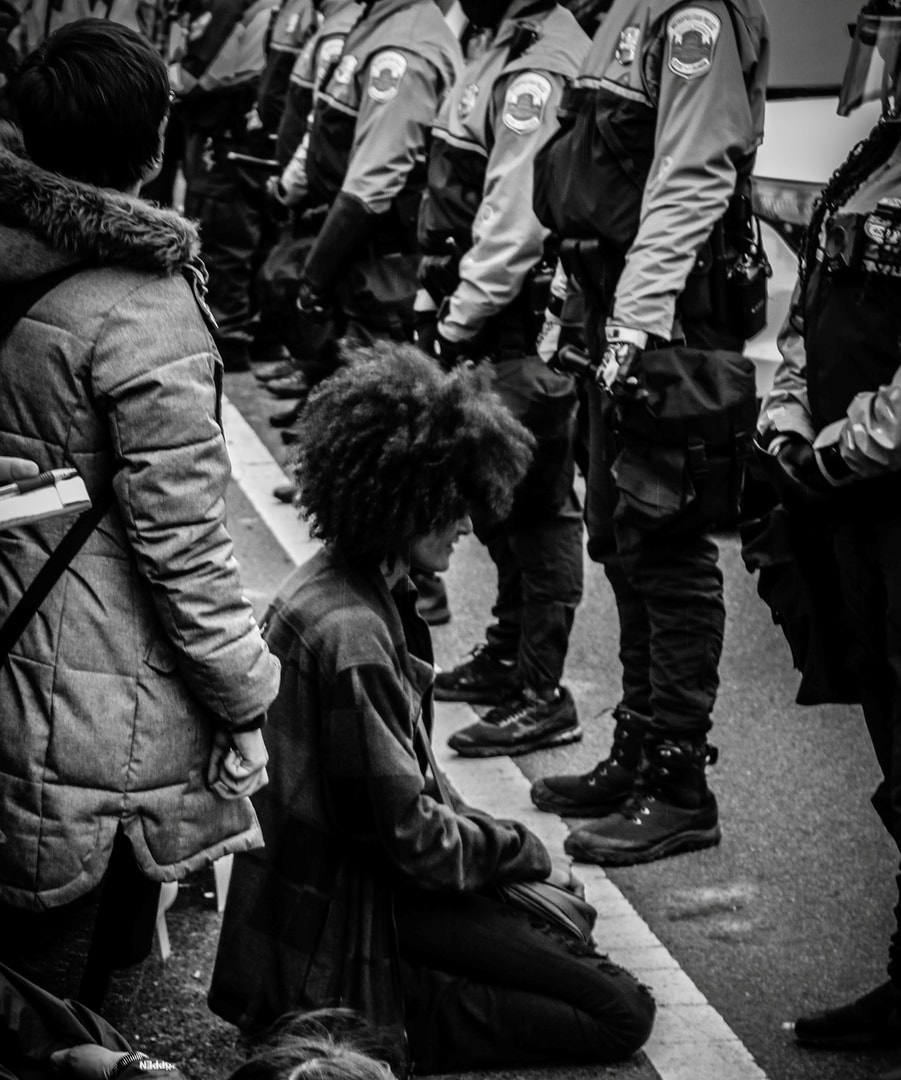The other day I was engaged in an online debate about Christianity and nonviolence when the other participant stated the following: “Pacifism is a luxury allowed in a country that is free from tyranny because of their justice [system] and military strength.”
I’m not sure if my conversation partner was referencing it, but it reminded me of a bumper sticker I saw once: “Pacifism is a luxury paid for by warriors.”
Even though I’ve spent the last decade or so attempting to practice and promote creative nonviolence (my preferred term vs. pacifism), I’ll be the first to admit that a certain undeniable logic underlies this sentiment.
After all, it feels like a luxury to be able to promote nonviolence while living comfortably in rural Canada, as I do, where the probability of physical harm being brought against me or my family is virtually nonexistent—except perhaps on the hockey rink. It allows me to deal mostly in hypotheticals, and doing so costs me almost nothing, except the occasional loss of a friend on Facebook.
It’s quite another thing to embrace this principle while living on the frontlines of one of the world’s many combat zones, with ISIS or Al-Shabaab or the Taliban threatening to beat down my door and take away my children, turning them into soldiers or sex slaves or worse. Unlike my situation, the decisions one makes in such a context have almost immediate life-or-death consequences.
Creative Nonviolence vs. Pacifism
I’ll also be the first to admit that anyone who elevates pacifism to an absolute commitment to nonviolence, refusing to take up arms against anyone under any circumstances, could be seen as callous, perverse, cowardly, irresponsible, and immoral, a parasite on society who depends on others to do the dirty work of war, so the pacifist can retain his or her “purity.”
It’s easy to taunt such people with a range of “what if” scenarios, such as what they would do if a stranger broke into their home and threatened to kill their family, how they would deal with Hitler, and so forth. The assumption is that a committed pacifist would merely stand by and do nothing for fear of violating his or her precious ideal. And as Edmund Burke once told us, “The only thing necessary for the triumph of evil is for good men to do nothing.”
However, such thinking betrays a critical error that consistently inhibits people from considering creative nonviolence as a viable option when confronted by evil. That error is the notion that pacifism amounts to “passive-ism,” i.e., doing nothing. This is why I prefer the term “creative nonviolence” because it sounds much more assertive. And even a cursory glance at the history of nonviolence, both Christian and otherwise, reveals that pacifism is anything but meek and cowardly.
Pacifism Does Not = Passive
Starting with my faith tradition, Christianity, Jesus can hardly be considered passive in his response to violence.
When confronted by the Roman occupiers and the Jewish political and religious authorities that were colluding with them, rather than stand by and watch them abuse the populace, Jesus confronted them continually, using all sorts of creative approaches not only to empower and emancipate the victims of social and physical violence but also to free the perpetuators from their bondage to the sword.
Through his life and teachings, Jesus demonstrated such a consistent commitment to nonviolence and such a thorough deconstruction of the ruling authorities’ claims to legitimacy through the use of deadly force that eventually they felt they had no choice but to kill him, lest his ideas spread to the point that it became impossible to rule.
As perhaps the finest demonstration of the futility of violence, rather than put an end to the uproar, Jesus’s crucifixion and subsequent resurrection were the very things that emboldened his disciples to follow in his footsteps. Rather than quell the burgeoning movement, the targeting of Jesus only made it stronger.
Think about it. Who can afford to be violent? Answer: the rich and the powerful.
The Price of Nonviolence
Over the next few centuries, thousands of Christians were executed by the state for their refusal to participate in the military or worship gods that were themselves paeans to violence. Eventually, their consistent witness won out. Though Christianity—and the world—paid a heavy price for its collusion with the Roman Empire, the eventual “legitimization” of the faith enabled some good Christian ideals to permeate the empire and pacify much of Rome’s most egregious tendencies.
Throughout the ages since then, people from all sorts of backgrounds have chosen nonviolent responses in response to the violence brought against them. Think of the Cherokees’ refusal to relocate after their land was seized by the United States Government in 1838, which led to their forced march along the Trail of Tears. Also consider the White Rose

Resistance in Germany, an intellectual movement that sought to undermine Nazi rule from within. Then there’s Mahatma Gandhi’s Salt March, which was a watershed movement in India’s struggle for independence; the Montgomery Bus Boycott, which kicked off the Civil Rights Movement in America; the Tiananmen Square protests against political corruption and the muzzling of the press in China; and the Orange Revolution, which led to nonviolent regime change following a corrupt election in Ukraine. In these and numerous other situations, those committed to nonviolent solutions rose up, made their voices heard, and in many cases transformed their part of the world.
This brings me to a second error perpetuated by critics of nonviolence, the idea that pacifism is an extravagance available only to those who are fortunate enough to have no immediate safety concerns, thanks to the sacrifices others have made on their behalf. Looked at this way, rather than a luxury, pacifism seems cheap because the consequences of holding to such a view are so low.
However, as virtually all of the above examples make clear, those who pursued nonviolence in these cases were not individuals who had everything but rather those who were on the verge of losing everything.
Eschewing violence in favor of nonviolent alternatives was often the only means available to them, and it exacted a terrible price. Every member of the White Rose Resistance was beheaded. Between 2,000–8,000 Cherokees died along the Trail of Tears. Dozens of civil rights demonstrators were beaten and killed. And unknown hundreds of protestors were killed in the Tiananmen Square massacre.
Thus, as musician and pastor Josh Porter puts it in my new documentary, J.E.S.U.S.A., nonviolence is a terrible idea if your goal is immediate self-preservation. But if you take a broader view, although creative nonviolence may look like an abysmal failure at first, in the long run, a remnant’s decision to jump off the merry-go-round of never-ending violence could change everything.
So, if you define a luxury item as something that comes at an immense cost, nonviolence certainly fits the bill, but it’s far from an indulgence available only to a chosen few.
The Olive
Branch
Take A Breath with Us
Our weekly newsletter creates a space to take a breath. Once we slow down, we can see the way desire, imitation, and conflict operate in our lives and in the world, and begin to create peace. In addition to the newsletter, you will receive the free "Unlearn the Bible" ebook when you subscribe.
Violence: The Greatest (& Most Expensive) Luxury

In fact, if you want to talk about privilege, the greatest luxury in the world is not pacifism but violence.
Think about it. Who can afford to be violent? Answer: the rich and the powerful.
In contrast, those who are poor, weak, or marginalized often have no choice but to offer a nonviolent response in the face of evil—to flee, surrender, or capitulate.
Rather than pacifists acting as parasites on society, stealing from those who are willing to pay the price of war, it’s the warmongers who steal from the poor and the weak, literally sucking their blood as they send them off to kill, to die, and to destroy. Worst of all, the warmongers play on our ideals and good intentions, deluding us into thinking their desire for power and wealth is aligned with our self-interest and the good of the world.
In this and many other ways, violence continues to exact a compounding price. As Walter Wink points out:
We want to believe in a final violence that will, this last time, eradicate evil and make future violence unnecessary. But the violence we use creates new evil, however just the cause. It inculcates the longing for revenge, and for what the losers call “justice.” And they will have learned from our example how to use violence more efficiently. Violence can never stop violence because its very success leads others to imitate it. Paradoxically, violence is most dangerous when it succeeds. (Emphasis in the original) Walter Wink. Engaging the Powers. (Minneapolis: Fortress Press, 1992), p. 216.
Choosing Creative Nonviolence
The good news is, proponents of creative nonviolence can take advantage of this same human tendency toward imitation. Doing so takes an immense amount of courage, not only because it puts us at the mercy of our enemies but also because it may make us look ridiculous in the short term, and it invites a tremendous amount of criticism from those who are still beholden to the illusion of violence.
However, in response to such critics, I offer this paraphrase of a quote by G. K. Chesterton regarding Christianity: “The nonviolent ideal has not been tried and found wanting. It has been found difficult and left untried.”
If we, like my online debating partner, truly want to live in a world that is free, just, and strong, nonviolence is our only hope.

